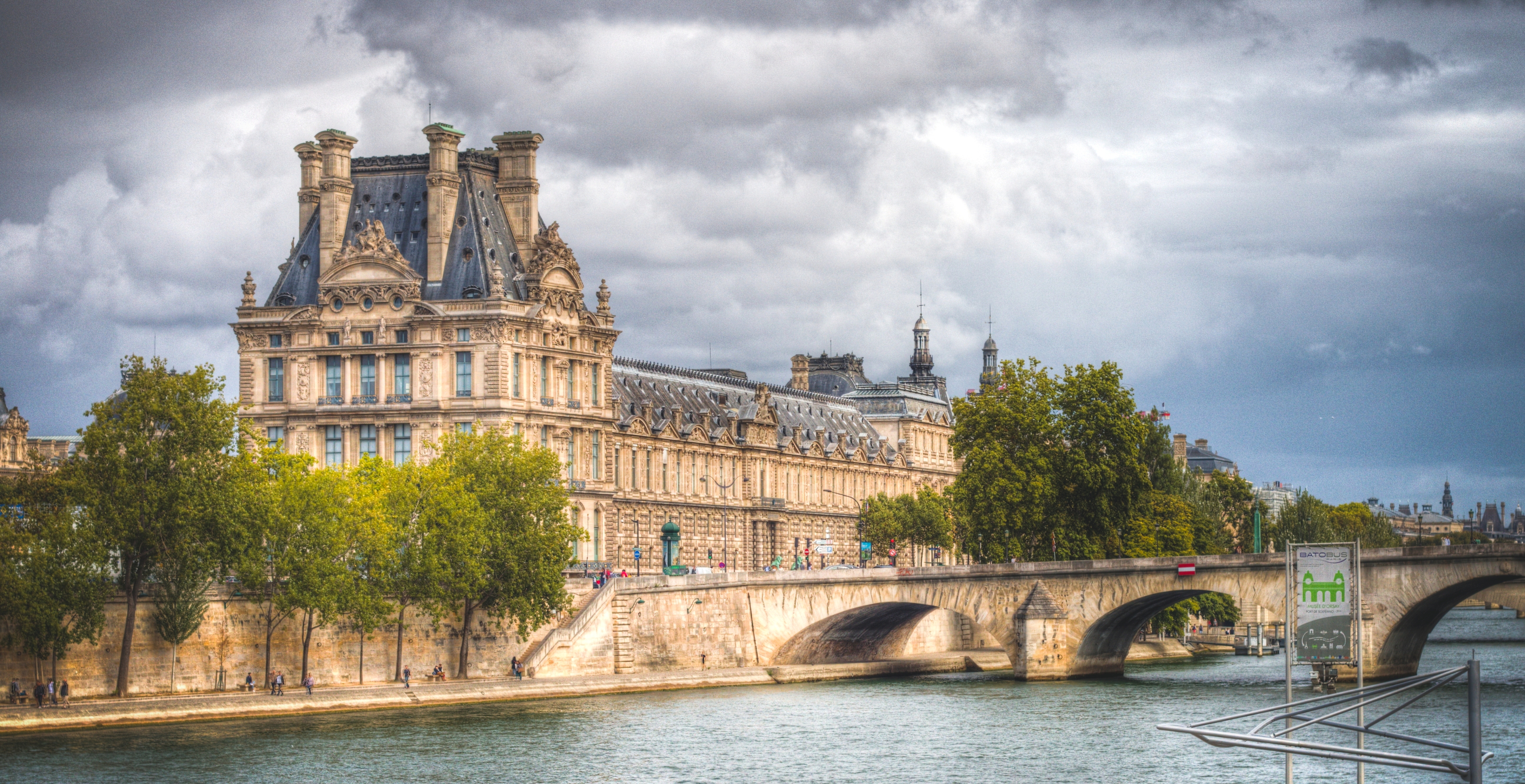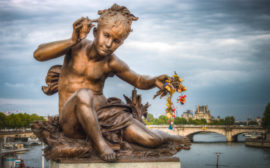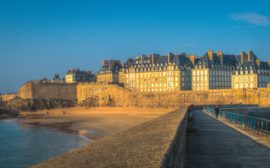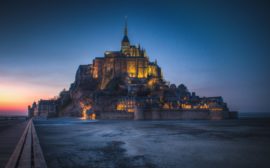First up was the Louvre. Angela and I were staying at a hotel in Montmartre, which is pretty convenient for a trip to the Louvre as it’s a direct shot south on the #95 bus. Plus, if you take the bus while in Paris it makes you feel like more of a local, so we were quite happy to do it. The bus drops you right in front of the Louvre’s main entrance, an introduction to the museum that immediately makes an impression.
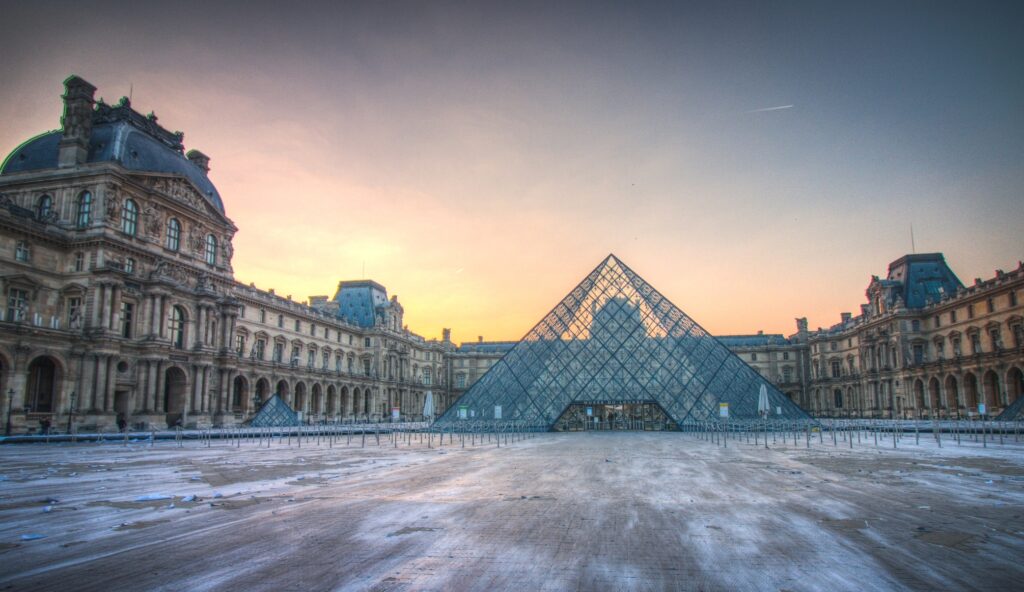
The Louvre Pyramid is quite a sight, offering a juxtaposition between I.M Pei’s glass and steel design in a courtyard bordered by the classic French Renaissance style of the original buildings. Some Parisians hate it – it’s been called “a scar on the face of Paris!” more than once, but many love it and it’s certainly become one of the most recognizable landmarks in Paris. I dug it, and enjoyed how the sunlight played off the glass, creating an ever-changing look to the square.
As it was a nice day in the summer, we expected the lines to be insane, but things were quite manageable. We got inside in less than five minutes and then waited less than ten to get our tickets. At only €15 each, the Louvre is one of the best deals in town.
If you only have one day to explore the Louvre, it’s a good idea to plan out your route so you’ll see the works of art you’re hoping to see. The museum is divided up into three wings (Denon, Sully, and Richelieu). The Louvre provides good maps and also highlights locations where some of the most famous works are located, making it easy to plan your day. One piece of advice – the sheer size of the Louvre can catch people off guard, so give yourself time to get from place to place. The other thing is that some of the “non-marquee” works are pretty amazing – you will almost certainly find yourself getting wrapped up in the thousands of pieces of art you’re likely to pass as you zip from the Mona Lisa to the Venus di Milo.
So a good plan of action is to focus on one wing at a time – you’ll certainly make life easier on yourself. The reality is that if you’re only there once you’ll probably try to see your favourite pieces, running from wing to wing. Just consider your route before you start, trust me. The place is huge.

So we put our plan in place, and decided to go straight to the Mona Lisa first while the museum wasn’t all that busy, and then explore the rest at a leisurely pace. I know it’s touristy and tacky to admit that the Mona Lisa was first on our list, but let’s be honest – even if it’s not your favourite work of art, you’re in the museum where the most famous painting in the world is being featured – of course you’re going to go see it.
It was a good plan – the Mona Lisa is housed in a massive room to accommodate pushy crowds. On this day we were able to navigate our way up front in just a couple of minutes. It’s housed behind a plexiglass sheet (hence the reflection on the photo), a velvet rope, and I’m sure at least 440 layers of security that the public never sees.

It looks all calm and serene, but here’s the reality (and this was a relatively quiet day)…

Even so, I enjoyed taking in da Vinci’s masterwork; one thing I’ve gotten much better at is taking a few minutes in the moment. I put away my camera and just stood in front of the painting and tried to enjoy it without rushing through. I saw countless people run up, snap a pic, and run away. I want the pic, like everyone else, but I also want to create real memories beyond the selfie. Sounds sappy, I know, but I’ve been really fortunate to see some amazing things in this great big world – why not enjoy them?
Finishing up with the Mona Lisa we made our way into the Grand Gallery. I liked this work of David and Goliath, painted by Daniele da Volterra, a Tuscan artist of the sixteenth century (and friend of Michelangelo). da Volterra used both sides of the canvas, painting the scene from different perspectives. So you can take in one side of it, walk around the back, and take in the other.


This museum is way too big to cover in a day, and way too big to list every work of art that captured our imaginations. So I’ll hit a few highlights:
Angela really enjoyed the work of Giovani Paolo Panini – here’s one of his showcased works (sorry for the warped frame – tight crowds meant I had to get close, which led to some distortion – the actual frame is perfect – I promise 🙂

Concert given by Cardinal de La Rochefoucauld at the Argentina Theatre in Rome, on the Marriage of Louis the Dauphin, to Marie-Josephe of Saxony by Giovani Paolo Panini
I was more partial to some of the massive gateways and statues that lead from one section of the Louvre to the next:

And of course some of the highlight statues like the The Winged Victory of Samothrace…

…and the Venus de Milo.

I also dug some of the more unsung statues, like this head from Easter Island:

The Louvre is chock full of amazing history, paintings, sculptures, and other art works, but the building itself and the scenery that surrounds it is also pretty spectacular:
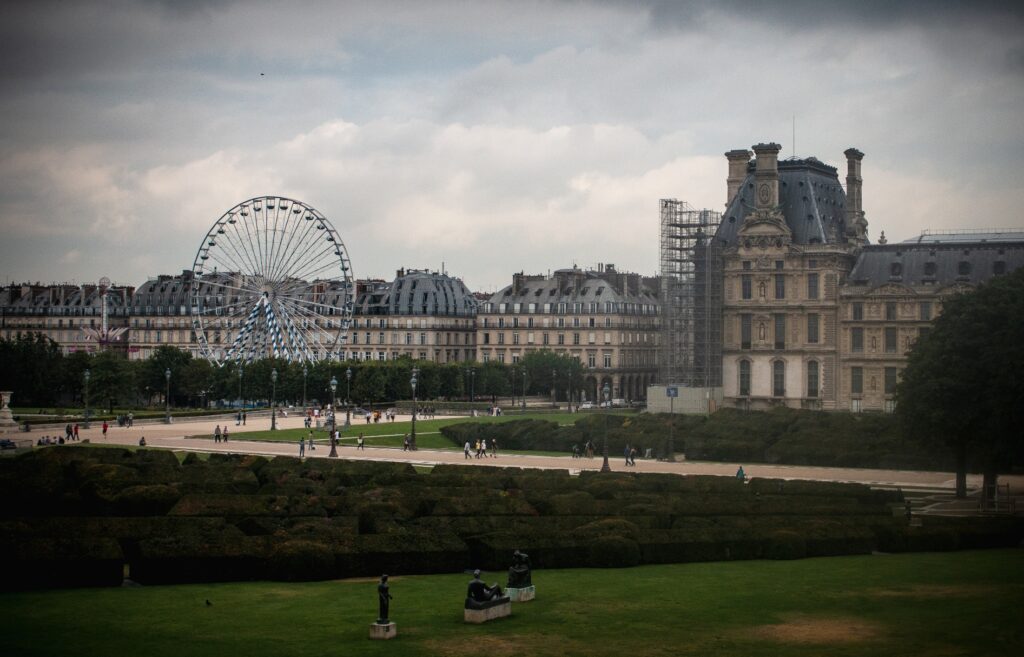
The Louvre is one of those national treasures that must be visited, at least once in a lifetime. We didn’t come close to covering it all in our day there, but I’m thrilled we made the effort. I was sure that no museum in France could touch it, until we visited the Musée d’Orsay.
We visited the Musée d’Orsay with our friends, Brendan and Kim, along with their amazing kids Bella and Finn. Along the way, the clouds threatened, but it gave us this amazing look at the Paris Eye as we walked:
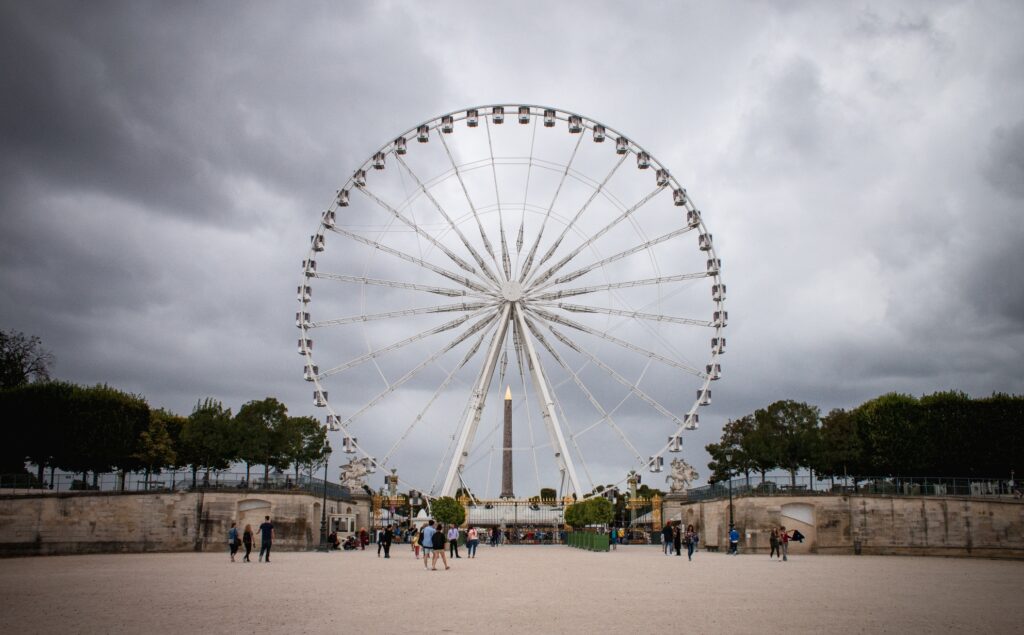
The clouds made good on their threat, the rain pelting down upon us just as we got to the museum. So we started off by having crepes in the rain outside the entrance, because in Paris you have crepes in the rain. It’s just the way it is. Feeling more and more French by the minute, I also considered taking up smoking and extending all my lunch breaks by an hour.
Heading inside (after paying our very affordable €12 admission), I was immediately struck by the architecture. Built in the former Orsay train station, it still maintains that old rail station feel.

The Musée d’Orsay is deceptive. Built on three levels that don’t look that big (but are, in fact, huge), this place impresses. It impresses with impressionism and post-impressionism, featuring works from Monet, Degas, Renoir, Manet, Cézanne, Gauguin, Van Gogh, and many others. One of the largest art museums in Europe, the Musée d’Orsay holds the biggest collection of art from the impressionism era in the world.
When you enter on the lower level you’ll come face-to-face with a familiar figure. Created by the original artist responsible for the Statue of Liberty in New York (Auguste Bartholdi), this version was created in 1889 and exhibited at the 1900 Universal Exhibition in Paris. It was meant to be shown in a gallery, so while I heard a few people comment “this doesn’t seem right here,” while I was looking at it, according to Batholdi, this is exactly where he would have liked to see it.

We began on the top floor and worked our way down. There are plenty of ways to tackle this place – I read somewhere that if you want to do it chronologically you should start on the first floor, go up to the top, and then do the middle. We weren’t concerned with being chronologically accurate, so we started at the top and worked our way down.
The highlight paintings always draw a crowd, including my favourite on the day, Van Gogh’s Starry Night Over the Rhone.

I also enjoyed seeing some of Monet’s work, including London, Houses of Parliament. The Sun Shining through the Fog. His use of light and colour is much more effective when you see it in person.

And of course, it was great to see some of Monet’s work from his gardens in Giverny. We were in Giverny during our time in France, so translating what we saw in the real world to his work on the canvas was quite cool.

The museum is massive, and you’ll need to pace yourself, lest you pull a hammy. And if you’re worried about staying on time, there are plenty of clocks around…


There was more space to move than the Louvre, and it had a completely different, more laid-back feel to me. Talking to Brendan, Kim, Bella, Finn, and Angela, I realized we all had different highlights – this place certainly has something for everyone. And just remember, if you find yourself caught in the rain while waiting in line, there’s a crepe stand nearby – and that makes everything okay.
A quick note – in this post I included a number of photos of various works of art. One of the things that always amazes me about seeing art in person is how much better it is than the versions you see online or in books. The brushstrokes jump off the canvas, the colours are more vibrant, and you get a much better sense of size, perspective, etc. So while I’ve included some photos here, I do recognize they don’t do justice to the originals – these are really just for informational purposes. Cheers!
Thoughts on either of these amazing museums? Please comment below!

